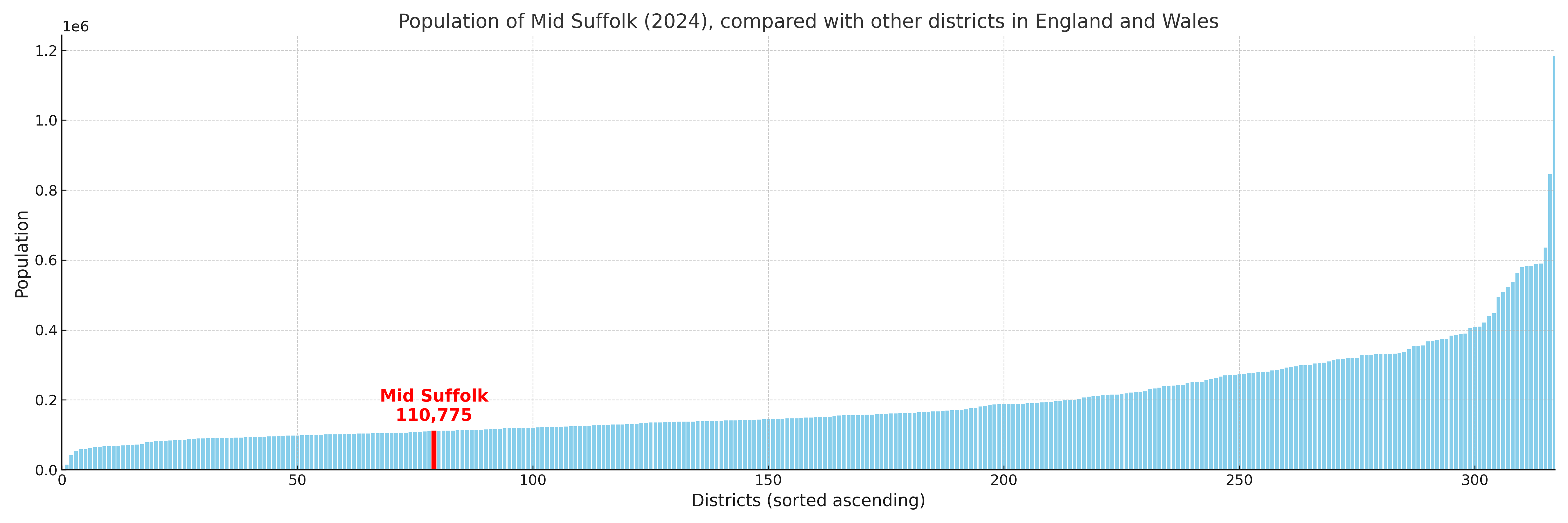Mid Suffolk
§ This page gives an overview of the Mid Suffolk local authority district, bringing together key facts, maps, and data to help you quickly understand the area. One of 361 district profiles on Baseview.
Overview ⁞ Mid Suffolk is a predominantly rural district filled with villages, farmland, and market towns. Stowmarket is the principal town, with the Museum of East Anglian Life and riverside parks, while Eye and Needham Market add historic interest with churches, castles, and traditional streets. The countryside is characterised by meadows, woodlands, and agricultural fields, dotted with windmills and timber-framed houses. Its landscape reflects a quintessential Suffolk rural setting.
Mid Suffolk Boundary Map
This map shows the official boundary of the Mid Suffolk local authority district, based on the latest geographic data published by the Office for National Statistics (ONS). It provides a clear view of the district’s extent and helps you understand how the area fits within the wider regional and national landscape.
Contains OS data © Crown copyright and database right 2025. Source: Office for National Statistics licensed under the Open Government Licence v3.0.
The administrative boundary of Mid Suffolk can also be viewed on OpenStreetMap: District Boundary of Mid Suffolk.
Key Facts about Mid Suffolk
What region is Mid Suffolk in? Mid Suffolk is in the East of England of England, a region within the UK.
What county is Mid Suffolk in? Mid Suffolk is located in the county of Suffolk.
Is Mid Suffolk a city? No, Mid Suffolk is not a city. (Note: the UK has 76 officially designated cities.)
Who governs Mid Suffolk? The local authority for this district is: Mid Suffolk District Council - responsible for district-level services. Since Suffolk is a two-tier area, county-level services are handled by: Suffolk County Council.
▶ Official website of Mid Suffolk District Council 🔗 midsuffolk.gov.uk

Which police force covers Mid Suffolk? Policing in Mid Suffolk is provided by Suffolk Constabulary 🔗 suffolk.police.uk, which serves 5 local authority districts: Babergh ⁞ East Suffolk ⁞ Ipswich ⁞ Mid Suffolk ⁞ West Suffolk.
Mid Suffolk in International Geographies
In the International Territorial Levels (ITLs) hierarchy, Mid Suffolk is within an ITLs Level 3 area:
- (ITL 1) East of England
- (ITL 2) ⇒ Suffolk
- (ITL 3) ⇒⇒ Babergh and Mid Suffolk
The International Territorial Levels are used by OECD member countries for statistical purposes to classify administrative areas. We have this listable page for easy browsing of ITL names and codes: International Territorial Levels.
Constituencies in Mid Suffolk
Mid Suffolk is divided into 3 parliamentary constituencies, listed below in alphabetical order.
A constituency is a specific geographical area that elects one Member of Parliament (MP) to represent them in the House of Commons. The United Kingdom is divided into 650 parliamentary constituencies. We have this list page for easy browsing of all UK parliamentary constituencies: List of Constituencies.
Wards in Mid Suffolk
Mid Suffolk is divided into 26 wards, listed below in alphabetical order.
- Bacton
- Battisford & Ringshall
- Blakenham
- Bramford
- Chilton
- Claydon & Barham
- Combs Ford
- Debenham
- Elmswell & Woolpit
- Eye
- Fressingfield
- Gislingham
- Haughley, Stowupland & Wetherden
- Hoxne & Worlingworth
- Mendlesham
- Needham Market
- Onehouse
- Palgrave
- Rattlesden
- Rickinghall
- St Peter's
- Stonham
- Stow Thorney
- Stradbroke & Laxfield
- Thurston
- Walsham-le-Willows
In the UK, a ward is a subdivision of a local authority area, used mainly for electoral and statistical purposes. Defined by the ONS, wards represent the primary unit for local elections, each returning one or more councillors to the local council. Wards are also used as a key geography for presenting population and census data.
Parishes in Mid Suffolk
Mid Suffolk is fully parished: 123 civil parishes, listed A-Z below.
- Akenham
- Ashbocking
- Ashfield cum Thorpe
- Aspall
- Athelington
- Bacton
- Badley
- Badwell Ash
- Barham
- Barking
- Battisford
- Baylham
- Bedfield
- Bedingfield
- Beyton
- Botesdale
- Braiseworth
- Bramford
- Brome and Oakley
- Brundish
- Burgate
- Buxhall
- Claydon
- Coddenham
- Combs
- Cotton
- Creeting St. Mary
- Creeting St. Peter or West Creeting
- Crowfield
- Darmsden
- Debenham
- Denham
- Drinkstone
- Earl Stonham
- Elmswell
- Eye
- Felsham
- Finningham
- Flowton
- Framsden
- Fressingfield
- Gedding
- Gipping
- Gislingham
- Gosbeck
- Great Ashfield
- Great Blakenham
- Great Bricett
- Great Finborough
- Harleston
- Haughley
- Helmingham
- Hemingstone
- Henley
- Hessett
- Hinderclay
- Horham
- Hoxne
- Hunston
- Kenton
- Langham
- Laxfield
- Little Blakenham
- Little Finborough
- Mellis
- Mendham
- Mendlesham
- Metfield
- Mickfield
- Monk Soham
- Needham Market
- Nettlestead
- Norton
- Occold
- Offton
- Old Newton with Dagworth
- Onehouse
- Palgrave
- Pettaugh
- Rattlesden
- Redgrave
- Redlingfield
- Rickinghall Inferior
- Rickinghall Superior
- Ringshall
- Rishangles
- Shelland
- Somersham
- Southolt
- Stoke Ash
- Stonham Aspal
- Stonham Parva
- Stowlangtoft
- Stowmarket
- Stowupland
- Stradbroke
- Stuston
- Syleham
- Tannington
- Thorndon
- Thornham Magna
- Thornham Parva
- Thrandeston
- Thurston
- Thwaite
- Tostock
- Walsham-le-Willows
- Wattisfield
- Westhorpe
- Wetherden
- Wetheringsett-cum-Brockford
- Weybread
- Whitton
- Wickham Skeith
- Wilby
- Willisham
- Wingfield
- Winston
- Woolpit
- Worlingworth
- Wortham
- Wyverstone
- Yaxley
A civil parish is the lowest tier of local government in England, used for villages, small towns, and suburbs. They have their own local authority, either a parish council or a parish meeting, which provides local services like managing parks, allotments, and streetlights, and represents the community's views to larger councils.
Built-up Areas in Mid Suffolk
Mid Suffolk covers 67 built-up areas, listed below in alphabetical order.
- Ashbocking *
- Bacton and Cotton
- Badwell Ash
- Barking
- Battisford Tye
- Bedfield
- Beyton
- Bramford
- Brome
- Burstallhill
- Claydon
- Coddenham
- Crowfield
- Debenham
- Diss *
- Drinkstone Green
- Elmswell
- Eye (Mid Suffolk)
- Felsham
- Finningham
- Fressingfield
- Gislingham
- Great Blakenham
- Great Bricett *
- Great Finborough
- Haughley
- Heckfield Green
- Henley
- Hessett
- Hinderclay
- Horham
- Ipswich *
- Laxfield
- Mellis
- Mendlesham
- Metfield
- Nedging Tye *
- Needham Market
- Norton (Mid Suffolk)
- Occold
- Old Newton
- Pakenham *
- Palgrave
- Rattlesden
- Redgrave
- Rickinghall and Botesdale
- Sharpstone Street
- Somersham (Mid Suffolk)
- Stonham Aspal
- Stowmarket
- Stowupland
- Stradbroke
- Thorndon
- Thurston *
- Tostock
- Upthorpe (West Suffolk) *
- Walsham le Willows
- Wattisfield
- Wetherden
- Wetheringsett
- Wickham Skeith
- Wingfield
- Woolpit
- Woolpit Heath
- Worlingworth
- Wortham
- Yaxley (Mid Suffolk)
In the UK, a Built-up Area (BUA) is a continuous urban area of at least 20 hectares (0.2 km²), defined by the ONS as land where buildings are generally no more than 200 metres apart, such as towns, cities, or large villages. (Note: A BUA name marked with an asterisk (*) indicates that the area is situated partly in the district of Mid Suffolk.)
Mid Suffolk compared with other districts in the UK
This section shows how Mid Suffolk compares with other local authority districts in the UK, using a variety of measures and rankings.
Mid Suffolk has 26 electoral wards.

Mid Suffolk has a population of 110,775 (2024 mid-year estimate by ONS)

More local statistics and data for Mid Suffolk can be found on the ONS statistics for Mid Suffolk.